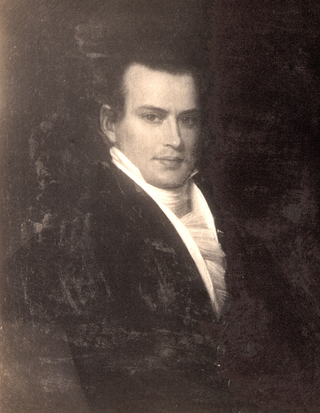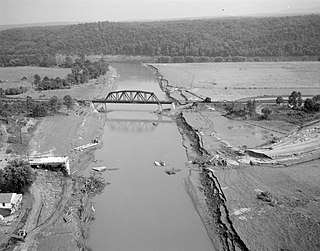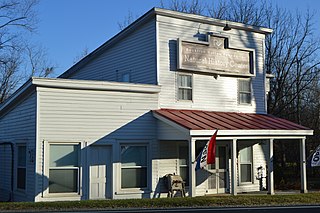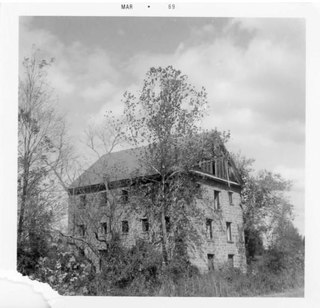Related Research Articles

Buckingham County is a rural United States county located in the Commonwealth of Virginia, and containing the geographic center of the state. Buckingham County is part of the Piedmont region of Virginia, and the county seat is Buckingham.

Amherst is a town in Amherst County, Virginia, United States. The population was 2,231 at the 2010 census. It is the county seat of Amherst County.

The Southwest Mountains of Virginia are a mountain range centered on Charlottesville, parallel to and geologically associated with the Blue Ridge Mountains, which lie about 30 miles (50 km) to the west. Some of the more prominent peaks include Carters Mountain, Fan Mountain, Brush Mountain, Peters Mountain, Walton's Mountain, and Hightop Mountain.
William Cabell was an American planter, soldier, and politician who served more than four decades in both houses of the Virginia General Assembly representing the area of his and family members' plantations on the upper James River.

Shadwell is a census-designated place (CDP) in Albemarle County, Virginia. It is located by the Rivanna River near Charlottesville. The site today is marked by a Virginia Historical Marker to mark the birthplace of President Thomas Jefferson. It is listed on the National Register of Historic Places along with Clifton.

The Dismal Swamp Canal is a canal located along the eastern edge of the Great Dismal Swamp in Virginia and North Carolina in the United States. Opened in 1805, it is the oldest continually operating man-made canal in the United States. It is part of the Intracoastal Waterway.

William Cabell Rives was an American lawyer, planter, politician and diplomat from Virginia. Initially a Jackson Democrat as well as member of the First Families of Virginia, Rives served in the Virginia House of Delegates representing first Nelson County, then Albemarle County, Virginia, before service in both the U.S. House and Senate. Rives also served two separate terms as U.S. Minister to France. During the Andrew Jackson administration, Rives negotiated a treaty whereby the French agreed to pay the U.S. for spoliation claims from the Napoleonic Wars. During the American Civil War, Rives became a Delegate to the Provisional Confederate Congress and the Confederate House of Representatives.

William H. Cabell was a Virginia lawyer, politician, plantation owner and judge aligned with the Democratic-Republican party. He served as Member of the Virginia House of Delegates, as Governor of Virginia, and as judge on what later became the Virginia Supreme Court. Cabell adopted his middle initial in 1795—which did not stand for a name—to distinguish himself from other William Cabells, including his uncle, William Cabell Sr.

Buildings, sites, districts, and objects in Virginia listed on the National Register of Historic Places:

The Rockfish River is a 28.7-mile-long (46.2 km) tributary of the James River in central Virginia in the United States. Via the James River, it is part of the watershed of the Chesapeake Bay.

Alexander Rives was a Virginia attorney, politician and plantation owner. He served in both houses of the Virginia General Assembly, as a justice of the Supreme Court of Virginia and as a United States district judge of the United States District Court for the Western District of Virginia.

Castle Hill (Virginia) is an historic, privately owned, 600-acre plantation located at the foot of the Southwest Mountains in Albemarle County, Virginia, near Monticello and the city of Charlottesville, and is recognized by the Virginia Landmarks Register and the National Register of Historic Places. Castle Hill was the home of Dr. Thomas Walker (1715–1794) and his wife, Mildred Thornton Meriwether. Walker was a close friend and the physician of Peter Jefferson, and later the guardian of young Thomas Jefferson after his father's death.

Colleen is an unincorporated community in Nelson County, Virginia, United States. It was originally named Cabellsville. From 1761, Colleen was the first seat of government of the original Amherst County, when the county court first met at Henry Key's home near this central location in the newly-formed county and ordered William Cabell to survey the line dividing it from the former Albemarle County. The new courthouse was erected on Lunsford Lomax's land by March 1762. In 1807, Virginia's legislature formed Nelson County, so the county seat had to be relocated. The Amherst County judges met at New Glasgow and ordered a new courthouse built nearby. That frame courthouse was finished in 1810 and replaced by the current courthouse in 1870. Meanwhile, the Nelson County seat was transferred to Lovingston, and a courthouse built in 1809.

Norwood is an unincorporated community in Nelson County, Virginia, United States. It was among the communities severely affected by flash flooding from Hurricane Camille in 1969.
Shipman is a census-designated place (CDP) in Nelson County, Virginia, United States. The population as of the 2010 Census was 507.

Wintergreen is a census-designated place (CDP) in Augusta and Nelson counties, Virginia, United States, located near Wintergreen Resort. The population as of the 2010 Census was 165.

Wingina is an unincorporated community in Nelson County, Virginia, United States.

This is a list of the National Register of Historic Places listings in Albemarle County, Virginia.

Cobham Park, or Cobham Park Estate, is a historic estate located near Cobham, in Albemarle County and Louisa County, Virginia. The mansion was built in 1856, and is a rectangular 2+1⁄2-story, five bay, double pile structure covered by a hipped roof with three hipped roof dormers on each of the main slopes, and one dormer on each end. The house is an unusual example of ante-bellum period Georgian style architecture. It features front and rear, simple Doric order porches supported on square Ionic order columns. Also on the property are: two smokehouses, one brick and one frame, a frame dependency, and a simple two-story frame dwelling. It was the summer home of William Cabell Rives, Jr., (1825-1890), second son of the noted United States senator and minister to France William Cabell Rives.

Midway Mill was a historic grist mill located at Midway Mills, Nelson County, Virginia. It was built in 1787 by William H. Cabell (1772–1853), with minor alterations in 1810. It was a 4 1/4-story, uncoarsed ashlar stone rectangular structure with a slate gable roof. Associated with the mill were the contributing stone arch bridge and the late-19th century frame Simpson House. It once stood beside the James River and Kanawha Canal at the halfway point on the James River between Lynchburg and Richmond. It was demolished in 1998.
References
- ↑ "Midway Mills". Geographic Names Information System . United States Geological Survey, United States Department of the Interior . Retrieved December 18, 2022.
- ↑ Virginia Historic Landmark Commission staff (January 1973). "National Register of Historic Places Inventory/Nomination: Midway Mill" (PDF). Virginia Department of Historic Resources.
- ↑ "National Register Information System". National Register of Historic Places . National Park Service. July 9, 2010.
Coordinates: 37°39′58″N78°43′20″W / 37.66611°N 78.72222°W
